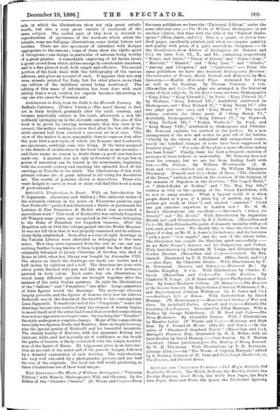Botticelli's Illustrations to Dante. 'With an Introduction by F. Lippmann.
(Lawrence and Bullen.)—The unknown writer of the sixteenth century, in his notes on Florentine painters, says that Botticelli "painted and illustrated a Dante on parchment for Lorenzo di Pier Francesco di Medici which was accounted a marvellous work." This work of Botticelli's was entirely forgotten till Waagen some years ago recognised in the volume belonging to the Duke of Hamilton the forgotten treasure. After the Hamilton sale in 1882 the volume passed into the Berlin Museum. It was not till then that it was properly examined and its authen- ticity fully established. Soon after a series of eight drawings in the Vatican Library were identified as belonging to the same series. How they were separated from the rest no one can say, nothing further being known of them beyond the fact that they originally belonged to Queen Christina of Sweden. who died in Rome in 1689, when her library was bought by Alexander VIII. The sheets on which the drawings are made are twelve and a hall inches by eighteen and a half. The drawings are done with silver point, finished with pen and ink, and in a few instances painted in body colour. Each canto has one illustration, in which many different episodes are brought together after the manner of the early Italian painters. In style the illustrations of the "Inferno" and " Purgatorio " are alike. Large quantities of little figures crowd the drawings. The grotesque element largely prevails, and the figures of demons show bow far inferior Botticelli was in the domain of the terrible to his contemporary Luca Signorelli. Towards the end of the " Purgatorio " series the drawings become less confused and the element of beauty begins to assert itself, as if the artist had found that crowded compositions were not so expressive as simpler ones. On reaching the " Paradiso" the style undergoes a complete change. Many of the compositions have only two figures, Dante and Beatrice. Here we begin to recog- nise the special genius of Botticelli and his beautiful invention. The stately beauty of Beatrice, with her garments flowing into intricate folds, and her heavenly air of confidence as she treads the paths of heaven, is finely contrasted with the simple trustful- ness of the figure of Dante. Mr. Lippmann gives in an introduc- tion an account of the artist and of the present designs, followed by a detailed explanation of each drawing. The reproductions are very well executed by a photographic process, and are half the size of the originals. The book was well worth producing, as these illustrations are of their kind unique.










































 Previous page
Previous page